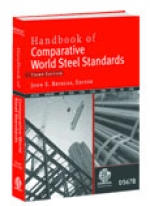Tab Article
Handbook of Comparative World Steel Standards
When comparing steel standards from different national and international standard development
organizations (SDOs), there is no such thing as equivalent steel standards. At best, one may be able
to group comparable steel standards together based on some defined set of rules, which has been
done in this handbook. For example, ASTM A 516/A 516M Grade 70 is comparable to JIS G 3118
symbol SGV 480 and to EN 10028-2 steel name P295GH, based on chemical compositions and
mechanical properties. Yet they are not equivalent since there are differences in their chemical
compositions and mechanical properties. Comparing steel standards is not an exact science and
cannot be made into a mathematical equation where two sides of an equation are equal to one
another, since there will always be differences between standards.
These differences may be significant to one user, but not significant to another user. Therefore, this
handbook uses the term comparative to denote similar standards that have been compared to each
other. Comparative is a relative word that is inevitably dependent upon the end user's requirements,
who is ultimately responsible for selecting the appropriate steel for a specific application.
There are some steel standards that are shared by multiple SDOs. For example, EN ISO 4957 – Tool
Steels, is a standard that is shared within the European Committee for Standardization (CEN) and
the International Standards Organization (ISO) systems. Consequently, the data are equivalent in
both systems, but there is only one standard.
There are also different standards that share the same grades of steel. For example, ASTM A 485
and EN ISO 683-17 share seven identical bearing steel grade chemical compositions, yet the body of
each standard is different (that is, grain size, hardenability, microstructure and hardness,
inspection, testing, etc.). As a result, these seven bearing steels within these two standards are not
equivalent, but are comparable.


